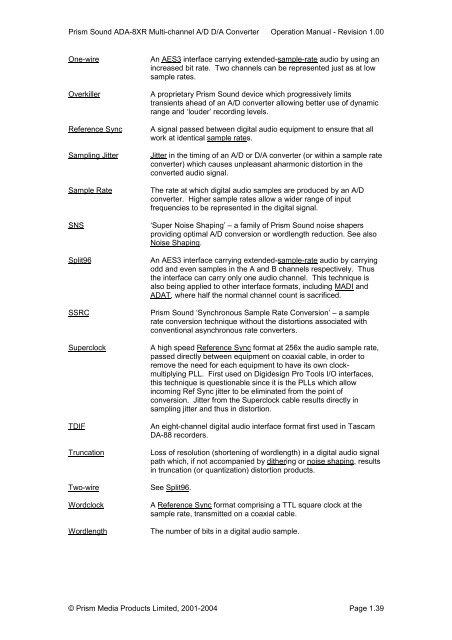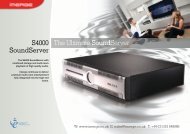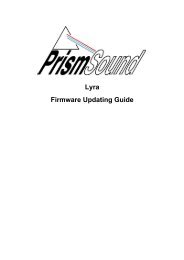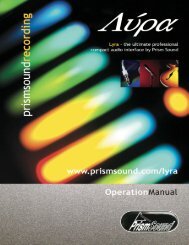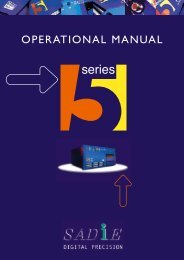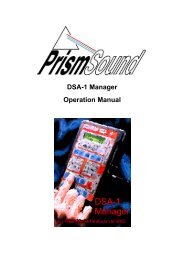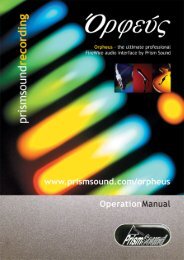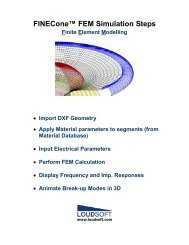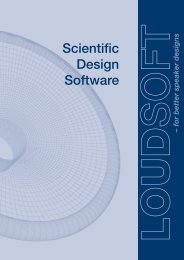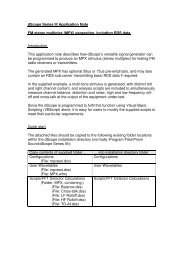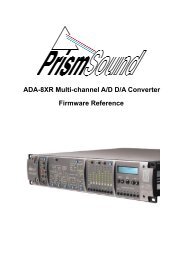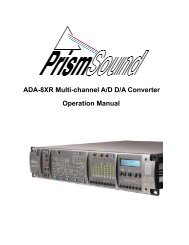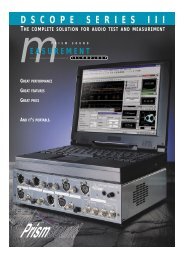ADA-8XR Multi-channel A/D D/A Converter Operation Manual
ADA-8XR Multi-channel A/D D/A Converter Operation Manual
ADA-8XR Multi-channel A/D D/A Converter Operation Manual
Create successful ePaper yourself
Turn your PDF publications into a flip-book with our unique Google optimized e-Paper software.
Prism Sound <strong>ADA</strong>-<strong>8XR</strong> <strong>Multi</strong>-<strong>channel</strong> A/D D/A <strong>Converter</strong> <strong>Operation</strong> <strong>Manual</strong> - Revision 1.00<br />
One-wire<br />
Overkiller<br />
Reference Sync<br />
Sampling Jitter<br />
Sample Rate<br />
SNS<br />
Split96<br />
SSRC<br />
Superclock<br />
TDIF<br />
Truncation<br />
Two-wire<br />
Wordclock<br />
Wordlength<br />
An AES3 interface carrying extended-sample-rate audio by using an<br />
increased bit rate. Two <strong>channel</strong>s can be represented just as at low<br />
sample rates.<br />
A proprietary Prism Sound device which progressively limits<br />
transients ahead of an A/D converter allowing better use of dynamic<br />
range and ‘louder’ recording levels.<br />
A signal passed between digital audio equipment to ensure that all<br />
work at identical sample rates.<br />
Jitter in the timing of an A/D or D/A converter (or within a sample rate<br />
converter) which causes unpleasant aharmonic distortion in the<br />
converted audio signal.<br />
The rate at which digital audio samples are produced by an A/D<br />
converter. Higher sample rates allow a wider range of input<br />
frequencies to be represented in the digital signal.<br />
‘Super Noise Shaping’ – a family of Prism Sound noise shapers<br />
providing optimal A/D conversion or wordlength reduction. See also<br />
Noise Shaping.<br />
An AES3 interface carrying extended-sample-rate audio by carrying<br />
odd and even samples in the A and B <strong>channel</strong>s respectively. Thus<br />
the interface can carry only one audio <strong>channel</strong>. This technique is<br />
also being applied to other interface formats, including MADI and<br />
<strong>ADA</strong>T, where half the normal <strong>channel</strong> count is sacrificed.<br />
Prism Sound ‘Synchronous Sample Rate Conversion’ – a sample<br />
rate conversion technique without the distortions associated with<br />
conventional asynchronous rate converters.<br />
A high speed Reference Sync format at 256x the audio sample rate,<br />
passed directly between equipment on coaxial cable, in order to<br />
remove the need for each equipment to have its own clockmultiplying<br />
PLL. First used on Digidesign Pro Tools I/O interfaces,<br />
this technique is questionable since it is the PLLs which allow<br />
incoming Ref Sync jitter to be eliminated from the point of<br />
conversion. Jitter from the Superclock cable results directly in<br />
sampling jitter and thus in distortion.<br />
An eight-<strong>channel</strong> digital audio interface format first used in Tascam<br />
DA-88 recorders.<br />
Loss of resolution (shortening of wordlength) in a digital audio signal<br />
path which, if not accompanied by dithering or noise shaping, results<br />
in truncation (or quantization) distortion products.<br />
See Split96.<br />
A Reference Sync format comprising a TTL square clock at the<br />
sample rate, transmitted on a coaxial cable.<br />
The number of bits in a digital audio sample.<br />
© Prism Media Products Limited, 2001-2004 Page 1.39


